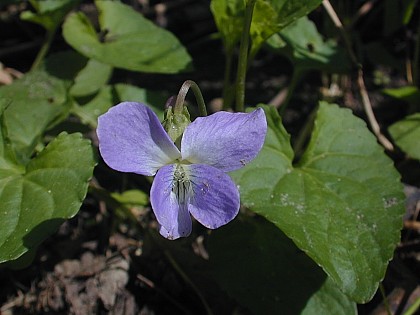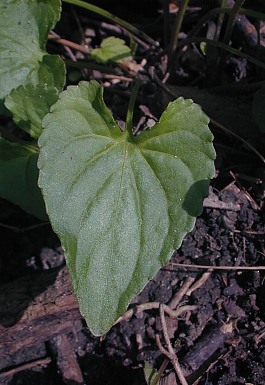Description: This herbaceous perennial plant consists of a rosette of leaves about 6" across, from which flowering stalks develop directly from the rootstock. Each blade of a basal leaf is up to 3½" long and 2½" across, while its petiole is about as long as the blade. The leaf blades are deltoid-cordate to oval-cordate, glabrous or nearly so, palmately veined, and crenate along their margins. The petioles are rather stout, pale green, hairless or nearly so, and widely spreading to ascending. The ascending flowering stalks are about as tall as the leaves; the stalks are pale green to pale reddish green and hairless.

Each stalk nods
downward at its apex and terminates in a single flower. Each flower is
about ½–¾" across, consisting of 5 pale blue-violet petals and 5 pale
green sepals. The lower lateral petals are bearded with white hairs
near the throat of the flower; the lowest petal and upper lateral
petals are beardless. The throat of the flower is white, and there are
dark blue-violet veins on the lowest petal and lower lateral petals
that function as nectar guides to flower-visiting insects. Sometimes
the white throat of the flower is surrounded by a band of blue-violet
that is slightly darker than the outer regions of the petals. At the
back of each flower, there is a short blunt nectar spur. The blooming
period occurs during mid- to late spring and lasts about 1½ months.
Somewhat later, cleistogamous flowers are produced that are
self-fertile; they lack showy petals. Each fertilized flower is
replaced by a tripartite seed capsule. The small seeds in each capsule
are dull light brown with oily elaisomes; they are ejected mechanically
from the capsule. The root system consists of a short crown with thick
rhizomes and fibrous roots. Reproduction occurs through the seeds and
rhizomes.
Cultivation:
The preference is light shade to partial sun, moist to mesic
conditions, and a fertile loamy soil with abundant organic material.

Range & Habitat:
The native Missouri Violet occurs occasionally throughout Illinois; it
is more
common in the southern half of the state than the northern half (see Distribution
Map). Habitats include deciduous woodlands (bottomland or
floodplain), woodland openings, areas along woodland paths, and rocky
bluffs. The Missouri Violet doesn't occur in sunny areas to the same
extent as Viola sororia sororia (Common Blue
Violet) and its various color forms.
Faunal Associations:
The flowers occasionally attract bees and other insects, including the
oligolectic Andrena viola (Violet Andrenid Bee).
These insects suck nectar from the flowers, although some of the bees
collect pollen. The caterpillars of several Fritillary butterflies (Speyeria
spp., Boloria spp., & Eupoieta
claudia) eat the foliage of Viola spp.
(Violets). Because of their oily elaisomes, the seeds are distributed
in part by ants. The seeds of Violets are eaten to a limited extent by
various birds and small rodents, including the Wild Turkey, Bobwhite,
Mourning Dove, and White-Footed Mouse. The Wild Turkey also eats the
foliage and fleshy rhizomes. Mammalian herbivores eat the foliage to a
limited extent.
Photographic Location:
Along a woodland path at Busey Woods in Urbana, Illinois.
Comments:
The Missouri Violet is very similar to Viola sororia sororia
(Common Blue Violet). It differs from the latter species in the
following ways: 1) the Missouri Violet has leaf blades that are more
deltoid (triangular-shaped) and less rounded than the blades of the
Common Blue Violet, 2) the flowers of Missouri Violet are a lighter
shade of blue-violet and slightly smaller in size than the flowers of
the Common Blue Violet, and 3) the seeds of Missouri Violet are a
lighter shade of brown. The Missouri Violet is even more similar to Viola
sororia priceana (Confederate Violet) because their flowers
are about the same shade of blue-violet. However, the Confederate
Violet has more rounded leaf blades, seeds that are a darker shade of
brown, and it is often found in close proximity to the Common Blue
Violet, with which it freely interbreeds. The Missouri Violet is
classified as a variety of Viola sororia by some
authorities, in which case its scientific name is Viola
sororia missouriensis.